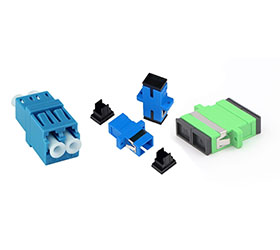Hunan Shuanglin Communication Technology Co.,Ltd.
Mobile:008618163716860
Tel:0086-731-89833256
Fax:0086-731-89603610
E-mail:
andy@sl-fibercable.com
Address:No.66 Zhongyi 1st Road,Yuhua District,Changsha,Hunan,
China

Description
Fiber optic adapters for ODFs and termination units, all of premium grade to fit any kind of application. Simplex, duplex and quadruplex connector options.
Technical Information Connector options:
SC, SC/APC, SC/MM (simplex, duplex)
LC, LC/APC (simplex, duplex, quad)
E2000, E2000/APC (simplex, duplex) FC
Fiber optic adapters (also called couplers) are designed to connect two fiber optic cables together. They come in versions to connect single fibers together (simplex), two fibers together (duplex), or sometimes four fibers together (quad).
Adapters are designed for multimode or singlemode cables. The singlemode adapters offer more precise alignment of the tips of the connectors (ferrules). It is ok to use singlemode adapters to connect multimode cables, but you should not use multimode adapters to connect singlemode cables. This can cause misalignment of the small singlemode fibers and loss of signal strength (attenuation).
When connecting two multimode fibers, you should always make sure they are the same core diameter (50/125 or 62.5/125). A mismatch here will cause attenuation in one direction (where the larger fiber is transmitting light into the smaller fiber).
Fiber optic adapters are typically connecting cables with similiar connectors (SC to SC, LC to LC, etc.). Some adapters, called "hybrid", accept different types of connectors (ST to SC, LC to SC, etc.). When the connectors have differing ferrule sizes (1.25mm to 2.5mm), as found in LC to SC adapters, the adapters are significantly more expensive because of a more complicated design/manufacturing process.
Most adapters are female on both ends, to connect two cables. Some are male-female, which typically plug into a port on a piece of equipment. This then allows the port to accept a different connector than for which it was originally designed. We discourage this use because we find the adapter extending from the equipment is subject to being bumped and breaking. Also, if not properly routed, the weight of the cable and connector hanging from the adapter may cause some misalignment and a degraded signal.
Our Factory:

For more information, please contact us!